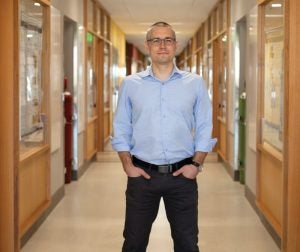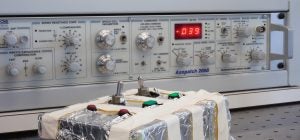~written by Bethany Deloof ’21
~contributing editor Buddini Karawdeniya ’18
Jason Dwyer, an associate professor of chemistry at the University of Rhode Island (URI), and his team are developing tools that can detect one molecule at a time.
Each molecule is pushed through a miniature detector — a small hole called a nanopore with dimensions one hundred thousandth of the diameter of a human hair — that allows them to be characterized.
According to Dwyer, the single molecules he’s looking at are complex biomolecules and the nanopore dimensions and properties must be carefully fine-tuned to ensure success. This ultra-sensitive technique allows Dwyer to determine whether any harmful molecular components are present and if the levels of such harmful contaminants are high enough to be consequential.
One demand for this research stems from the pharmaceutical industry’s desire for sensors capable of performing stringent quality assurance tests for the purity of their products. In 2008, the domestic supply of Heparin, a widely used anti-coagulant, was contaminated, and the contaminant went undetected with standard chemical tests — a mistake that proved fatal.

“There are tests that are much more sophisticated and expensive to detect the impurity,” says Dwyer.
“What we were able to do is — in a very inexpensive and rapid fashion — fingerprint Heparin and tell when there is a contaminant in it.”
After several years of research, Dwyer and his team demonstrated the ability of nanopore technology to reliably and quickly detect the same Heparin contaminant, using a much simpler and less costly approach than what had been necessary after the contamination crisis. His study was published in the prestigious Nature Communications journal in the summer of 2018.
“The test we came up with takes about 20 minutes and works at clinically relevant concentrations,” he says. “We always try to think about the consumer market. What we do in the lab is one thing — and it is a vital thing — but how do we translate our discoveries for benefit in the real world?”
Although Dwyer works in the URI Department of Chemistry, he attributes the success of his nanopore technology to drawing on skills and approaches that are more frequently associated with other disciplines across the University’s campus. While engineering expertise is required to design and develop new tools, attention to economics and manufacturing considerations helps to ensure effective future commercialization of a product, and social science approaches are required to best understand the needs, concerns and demands of the technology’s target audience.
Dwyer gives an example of a consumer’s needs, saying, “If I’m developing a medical diagnostic tool that’s going to be useful for people in communities without a regular supply of electricity, I should make sure my technology can be battery-powered or solar-powered. And, you have to be aware of what the demands are. Another aspect of Dwyer’s research involves creating nanopore technology to detect sugars — known more technically as glycans — found in aquatic environments, in pharmaceutical products and that play an important role in biological processes by acting as a source of food and energy for organisms.
The study of these glycans, or glycomics, therefore, constitutes both scientific research and it is of keen public health interest. But Dwyer takes studying sugars one step further to develop the tools needed to analyze — molecule by molecule — a type of sample that continues to challenge chemical analysis even without attempts to achieve such exquisite sensitivity.
Tool development and sugar analysis comprise two vastly different areas of work, and yet Dwyer believes the two sets of activities complement each other. Improved technology can lead to more effective detection of impurities, thus better informing efforts to eliminate such impurities and to increase public health safety.
“Glycan analysis is incredibly complicated, and in 2012, the National Academy of Sciences issued a call saying, ‘We need new tools to do this,’” says Dwyer. “We’re trying to answer that call.”
Funding for Dwyer’s lab and research comes from various sources, including: The National Institutes of Health, the URI Council for Research and Creativity, the Rhode Island Medical Foundation, and the National Science Foundation, from which the lab recently received a $302,000 award for work on nanopores in glycomics.

Recently, his team also received funding from the Rhode Island Science and Technology Advisory Council (STAC), which distributes grants to scientific research that addresses the needs — including economic needs — of Rhode Island. To add to the impressive collection of achievements and awards to his team, Dwyer recently won the 2019 Federation of Analytical Chemistry and Spectroscopy Societies SciX Innovation Award for his nanopore sensing technology.
Dwyer says a strength of URI is the breadth and richness of research taking place, with a college of engineering, college of pharmacy, college of the environment and life sciences, a graduate school of oceanography, and a state-of-the-art facility on campus where he conducts his research.
“There’s a tremendous amount of expertise on campus,” he says. “URI has the capabilities that I was looking for in terms of the expertise that’s here, and with proper laboratory facilities for this delicate research to be possible at all.”
Dwyer acknowledges his own attraction to novel technologies as a motivator in his work, but he notes that, ultimately, it is people and creative ideas that drive technological advancements. He credits his collaborators, and especially the graduate and undergraduate students whom he has mentored, with the continued success of nanopore technology research at the University.
“One of the interesting things about this is that the technology and the science are often strong drivers,” says Dwyer. “They’re flashy and that’s what interests people, but there’s also a human side to the story. I am not just referring to a focus on human health, but rather that all of this results from the inventiveness, curiosity and creativity of the people engaged in this work.”
Whether he’s analyzing molecules in pharmaceutical drugs or molecules present in aquatic environments, Dwyer aims to determine the types of molecules present, the quantity, and nature of these molecules, and how they interact with each other as well as their interactions with the human body’s microbiome.
“This is the discovery mission of the University,” Dwyer says. “Every time we do an experiment with a new molecule, it’s a new day for discovery.”
